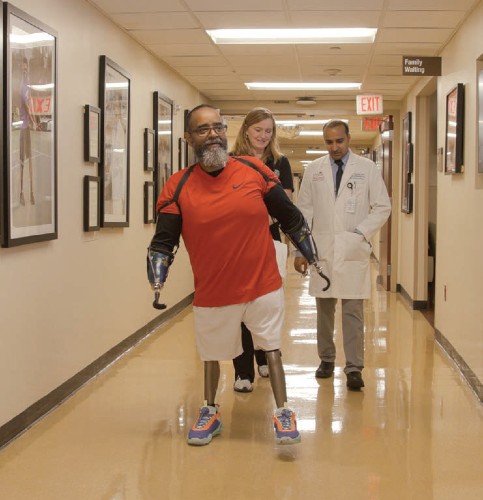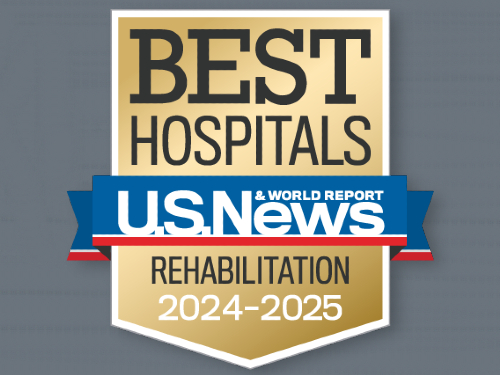“Osseointegration drastically improves quality of life for bilateral transfemoral amputees, allowing for a quick and comfortable way to take the prosthesis on and off.”
A multidisciplinary team is using a surgical procedure called osseointegration to provide people with limb loss like Louisiana native Wayne Moorehead with a new lease on life. The procedure creates a direct skeletal and functional connection between living bone and the surface of a load-bearing artificial implant.
“Osseointegration drastically improves quality of life for bilateral transfemoral amputees, allowing for a quick and comfortable way to take the prosthesis on and off,” explains Vinay Vanodia, MD, director of the Amputee and Limb Loss Rehabilitationprogram at TIRR Memorial Hermann.
For Moorehead, attachment and removal of prosthetics became a significant challenge due to his upper extremity amputations and the need for constant socket adjustments. A longtime truck driver, he enjoyed audiobooks and the solace of the road.
However, in 2018, his journey took an unexpected turn, as he was admitted to the hospital in July of that year due to a severe strep infection that had colonized on his heart, causing a blood infection. Moorehead’s body responded by limiting blood flow to his arms and legs. He had both his arms and legs amputated two months later, with the latter being bilateral transfemoral amputations, meaning that his legs were amputated above the knees.
After these procedures, Moorehead came to TIRR Memorial Hermann for three weeks of inpatient rehabilitation. On the day of his discharge, with bandages still on his arms and legs, the first thing he did was attend the Skills for Life workshop, a program that occurs every three years and provides educational content for patients with upper-extremity (and other) amputations. Visit enhancingskillsforlife.org for more information.

At Skills for Life, Moorehead found direction and met lifelong friends, and he was determined to learn and move on to the next phase of his journey.
“Wayne puts 110% into everything,” Dr. Vanodia notes.
In addition to learning how to manage day-to-day activities, Moorehead worked with physical therapist Kristin Reeves, the program manager of Limb Loss Services at TIRR Memorial Hermann, on basic mobility exercises. Activities such as bed mobility and transfers were vital, she says.
“Wayne needed to develop a new normal,” Reeves adds.
Balancing and strengthening came next with the help of an inflatable prothesis called a pneumatic post-amputation mobility aid. Moorehead also worked with Reeves on his posture, range of motion, core strength and more.
Finally, it was time to relearn how to walk, and the process of learning how to use prosthetics was long and difficult, he says. As a bilateral transfemoral amputee, Moorehead had difficulty with the prosthetic sockets that attached the prostheses to his body. Sweat from walking would cause the sockets to rotate and loosen. It then took about 45 minutes for him to put the prostheses back on.
Moorehead decided to try osseointegration, a surgical technique that eliminates the need for sockets. In January 2022, he underwent the first of two surgeries: a hollow metal tube was inserted into his femur bone; the tube is designed to integrate with the bone. Three months later, surgeons inserted an abutment that was screwed into the tube and sticks out of the skin. Each limb was reshaped during this procedure so that the prosthetic could attach onto the abutment efficiently.
Because the prosthetic is attached to the femur bone, patients can feel vibrations from the ground, allowing them to detect changes in elevation and texture as they walk. This improves comfort, safety and walking ability.
After osseointegration, Moorehead now walks 90% of the time. (He recently made his first road trip without bringing his wheelchair.) In addition, he has been driving again for nearly five years, using hand controls that are connected to the vehicle’s accelerator and brake pedals.
In fact, Moorehead regularly drives to Houston from his home in Louisiana to speak with patients at TIRR Memorial Hermann about how to “adjust to their new reality.” His valuable work in patient education also consists of walking clinics, support groups and even a speech at a national conference, according to Dr. Vanodia.
With the osseointegration implants, Moorehead is able to use shorter prosthetics called “stubbies” when at home, engaging bodypowered hooks to complete daily tasks. Soon, he will have a new pair of myoelectric hands, which he cleverly dubs his “dress hands,” meaning they are not to be worn while he is landscaping, laying edging and planting foliage for his wife, which are some of his favorite hobbies.
Moorehead’s family is very important to him; he helps in other ways such as picking up his grandchildren from school.
It has been a long journey, but Moorehead has persevered through it all and become independent in all his activities, according to Reeves and Dr. Vanodia. He is a firm believer in the importance of educating others about the new-found freedom that osseointegration has provided him.
“Anytime you need me, I’m there,” Moorehead says. “All you have to do is ask. I’ll be there.”
